Loading AI tools
≥2-dimensional tessellation or ≥3-dimensional polytope with identical faces From Wikipedia, the free encyclopedia
In geometry, a tessellation of dimension 2 (a plane tiling) or higher, or a polytope of dimension 3 (a polyhedron) or higher, is isohedral or face-transitive if all its faces are the same. More specifically, all faces must be not merely congruent but must be transitive, i.e. must lie within the same symmetry orbit. In other words, for any two faces A and B, there must be a symmetry of the entire figure by translations, rotations, and/or reflections that maps A onto B. For this reason, convex isohedral polyhedra are the shapes that will make fair dice.[1]
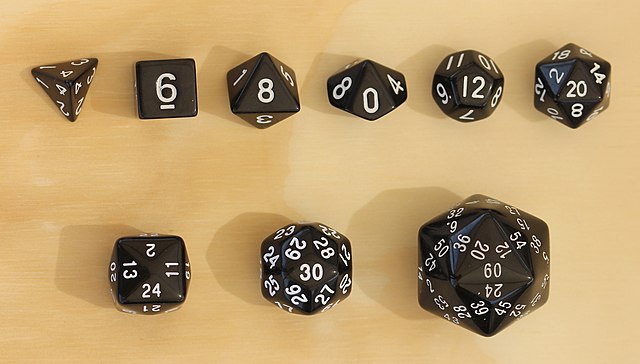
Isohedral polyhedra are called isohedra. They can be described by their face configuration. An isohedron has an even number of faces.
The dual of an isohedral polyhedron is vertex-transitive, i.e. isogonal. The Catalan solids, the bipyramids, and the trapezohedra are all isohedral. They are the duals of the (isogonal) Archimedean solids, prisms, and antiprisms, respectively. The Platonic solids, which are either self-dual or dual with another Platonic solid, are vertex-, edge-, and face-transitive (i.e. isogonal, isotoxal, and isohedral).
A form that is isohedral, has regular vertices, and is also edge-transitive (i.e. isotoxal) is said to be a quasiregular dual. Some theorists regard these figures as truly quasiregular because they share the same symmetries, but this is not generally accepted.
A polyhedron which is isohedral and isogonal is said to be noble.
Not all isozonohedra[2] are isohedral.[3] For example, a rhombic icosahedron is an isozonohedron but not an isohedron.[4]
| Convex | Concave | ||
|---|---|---|---|
 Hexagonal bipyramids, V4.4.6, are nonregular isohedral polyhedra. |
 The Cairo pentagonal tiling, V3.3.4.3.4, is isohedral. |
 The rhombic dodecahedral honeycomb is isohedral (and isochoric, and space-filling). |
 A square tiling distorted into a spiraling H tiling (topologically equivalent) is still isohedral. |
| Faces | Face config. | Class | Name | Symmetry | Order | Convex | Coplanar | Nonconvex |
|---|---|---|---|---|---|---|---|---|
| 4 | V33 | Platonic | tetrahedron tetragonal disphenoid rhombic disphenoid |
Td, [3,3], (*332) D2d, [2+,2], (2*) D2, [2,2]+, (222) |
24 4 4 4 |
  | ||
| 6 | V34 | Platonic | cube trigonal trapezohedron asymmetric trigonal trapezohedron |
Oh, [4,3], (*432) D3d, [2+,6] (2*3) D3 [2,3]+, (223) |
48 12 12 6 |
  | ||
| 8 | V43 | Platonic | octahedron square bipyramid rhombic bipyramid square scalenohedron |
Oh, [4,3], (*432) D4h,[2,4],(*224) D2h,[2,2],(*222) D2d,[2+,4],(2*2) |
48 16 8 8 |
     |  | |
| 12 | V35 | Platonic | regular dodecahedron pyritohedron tetartoid |
Ih, [5,3], (*532) Th, [3+,4], (3*2) T, [3,3]+, (*332) |
120 24 12 |
   |   |   |
| 20 | V53 | Platonic | regular icosahedron | Ih, [5,3], (*532) | 120 |  | ||
| 12 | V3.62 | Catalan | triakis tetrahedron | Td, [3,3], (*332) | 24 |  |   |  |
| 12 | V(3.4)2 | Catalan | rhombic dodecahedron deltoidal dodecahedron |
Oh, [4,3], (*432) Td, [3,3], (*332) |
48 24 |
   |  |   |
| 24 | V3.82 | Catalan | triakis octahedron | Oh, [4,3], (*432) | 48 |  |   | |
| 24 | V4.62 | Catalan | tetrakis hexahedron | Oh, [4,3], (*432) | 48 |   |   |   |
| 24 | V3.43 | Catalan | deltoidal icositetrahedron | Oh, [4,3], (*432) | 48 |   |    |  |
| 48 | V4.6.8 | Catalan | disdyakis dodecahedron | Oh, [4,3], (*432) | 48 |  |    |   |
| 24 | V34.4 | Catalan | pentagonal icositetrahedron | O, [4,3]+, (432) | 24 |  | ||
| 30 | V(3.5)2 | Catalan | rhombic triacontahedron | Ih, [5,3], (*532) | 120 |  | ||
| 60 | V3.102 | Catalan | triakis icosahedron | Ih, [5,3], (*532) | 120 |  |     | |
| 60 | V5.62 | Catalan | pentakis dodecahedron | Ih, [5,3], (*532) | 120 |  |      | |
| 60 | V3.4.5.4 | Catalan | deltoidal hexecontahedron | Ih, [5,3], (*532) | 120 |  |  |  |
| 120 | V4.6.10 | Catalan | disdyakis triacontahedron | Ih, [5,3], (*532) | 120 |  |    |    |
| 60 | V34.5 | Catalan | pentagonal hexecontahedron | I, [5,3]+, (532) | 60 |  | ||
| 2n | V33.n | Polar | trapezohedron asymmetric trapezohedron |
Dnd, [2+,2n], (2*n) Dn, [2,n]+, (22n) |
4n 2n |
     | ||
| 2n 4n |
V42.n V42.2n V42.2n |
Polar | regular n-bipyramid isotoxal 2n-bipyramid 2n-scalenohedron |
Dnh, [2,n], (*22n) Dnh, [2,n], (*22n) Dnd, [2+,2n], (2*n) |
4n |    |     |
A polyhedron (or polytope in general) is k-isohedral if it contains k faces within its symmetry fundamental domains.[5] Similarly, a k-isohedral tiling has k separate symmetry orbits (it may contain m different face shapes, for m = k, or only for some m < k).[6] ("1-isohedral" is the same as "isohedral".)
A monohedral polyhedron or monohedral tiling (m = 1) has congruent faces, either directly or reflectively, which occur in one or more symmetry positions. An m-hedral polyhedron or tiling has m different face shapes ("dihedral", "trihedral"... are the same as "2-hedral", "3-hedral"... respectively).[7]
Here are some examples of k-isohedral polyhedra and tilings, with their faces colored by their k symmetry positions:
| 3-isohedral | 4-isohedral | isohedral | 2-isohedral |
|---|---|---|---|
| 2-hedral regular-faced polyhedra | Monohedral polyhedra | ||
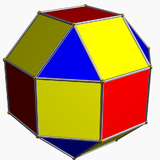 |
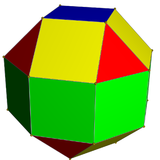 |
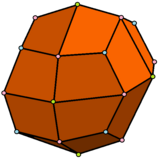 |
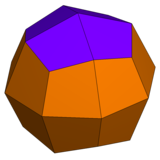 |
| The rhombicuboctahedron has 1 triangle type and 2 square types. | The pseudo-rhombicuboctahedron has 1 triangle type and 3 square types. | The deltoidal icositetrahedron has 1 face type. | The pseudo-deltoidal icositetrahedron has 2 face types, with same shape. |
| 2-isohedral | 4-isohedral | Isohedral | 3-isohedral |
|---|---|---|---|
| 2-hedral regular-faced tilings | Monohedral tilings | ||
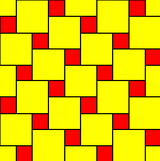 |
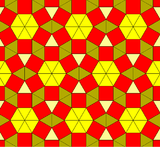 |
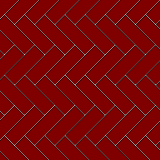 |
 |
| The Pythagorean tiling has 2 square types (sizes). | This 3-uniform tiling has 3 triangle types, with same shape, and 1 square type. | The herringbone pattern has 1 rectangle type. | This pentagonal tiling has 3 irregular pentagon types, with same shape. |
A cell-transitive or isochoric figure is an n-polytope (n ≥ 4) or n-honeycomb (n ≥ 3) that has its cells congruent and transitive with each others. In 3 dimensions, the catoptric honeycombs, duals to the uniform honeycombs, are isochoric. In 4 dimensions, isochoric polytopes have been enumerated up to 20 cells.[8]
A facet-transitive or isotopic figure is an n-dimensional polytope or honeycomb with its facets ((n−1)-faces) congruent and transitive. The dual of an isotope is an isogonal polytope. By definition, this isotopic property is common to the duals of the uniform polytopes.
Seamless Wikipedia browsing. On steroids.
Every time you click a link to Wikipedia, Wiktionary or Wikiquote in your browser's search results, it will show the modern Wikiwand interface.
Wikiwand extension is a five stars, simple, with minimum permission required to keep your browsing private, safe and transparent.